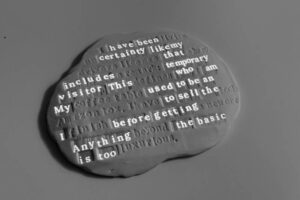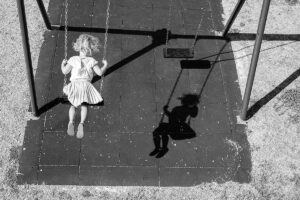Micro Four Thirds cameras from the OM System come with multiple computational modes to add to your creativity. One of those is ND Filters. Here’s how to use them and see results.
Scouting
I was scouting oak Creek in Sedona, Arizona to see how the changing leaf color was coming. Not so much quite yet. Instead of waiting the couple weeks that are probably needed, I decided to do some experimentation with my OM-1 camera (This link is to MPB, with used prices from $420-$1,060). Hiking along the creek, I changed to looking for compositions. I found some nice ones but felt a little more creativity was needed.
 ND 64 in-camera neutral density filter. Dappled sunlight was tamed with dodging and burning in post-production. Color comes from the blended water and reflections from the trees on the opposite bank.
ND 64 in-camera neutral density filter. Dappled sunlight was tamed with dodging and burning in post-production. Color comes from the blended water and reflections from the trees on the opposite bank.Neutral Density Filter
What I needed was some slowing for the water to give it a bit of a silky appearance, blending color and form into a more pleasing look. I didn’t have my ND filters on hand and the water wasn’t flowing quickly. It was frozen even at my slowest shutter speed and lowest ISO.
Enter the in-camera ND Filter settings. With the OM-1 you can simulate the ND filter look by capturing multiple exposures. The camera processes them. Anything that is not moving stays the same through each subsequent capture. Water, since it is moving, gets rendered multiple times and is blended together.
 Just across from where I was photographing my main composition was this rock and root highlighted by dappled sunlight. I darkened the scene to add a bit of mystery. Think this might be my favorite from the day.
Just across from where I was photographing my main composition was this rock and root highlighted by dappled sunlight. I darkened the scene to add a bit of mystery. Think this might be my favorite from the day.You have the choice of 6 EV from ND 2 to ND 64. In this case as the sun was shining brightly I used ND 64 for all of the images in this article. A usage note: Camera must be in Manual or Shutter Priority Mode to operate. I know I’ve spent a few minutes trying to find out why it won’t work while in Aperture Priority!
On the latest OM-1 Mark II camera, there is one more ND stop, ND 128 available (as of this writing I see some pretty hot deals on the Mark II).
Composition
When photographing the creek, I look for interesting combinations of rocks, boulders, tree limbs and logs. I’m looking to move the viewers eye around the image. A suggestion for when you work: don’t forget there are small movements in direction, focal length and orientation that make your images look totally different from one another.
 Vertical composition containing ‘three’. Rock in foreground, log and smaller rock in background. Reflections add depth and interest as well.
Vertical composition containing ‘three’. Rock in foreground, log and smaller rock in background. Reflections add depth and interest as well.Get to playing and exploring a scene from different angles. Tilt the camera. Change the aperture and shutter speed. You never know what you’ll find if you slow down. Look and explore a lot before even bringing the camera up to your eye. Once you’ve found something that catches you eye settle in for a while. You’ll find more than you think is possible.
A zoom lens is handy for playing with tightening up or letting space work in your photo. For all the images in this article, the OM System M.Zukio 40-150mm f/2.8 pro lens. The field of view is equivalent to 80-300mm on a full frame sensor.
“Dodging and burning are steps to take care of mistakes God made in establishing tonal relationships.” – Ansel Adams
Post production
Don’t forget post production to enhance what you have captured on the sensor. As Ansel Adams suggested, dodging and burning are for getting your tones looking proper. You can create extra depth and dimension. You can bring attention to some things and take it away from others. Sharpening and blurring can also be of help. Sharper areas will get attention and softer areas will get explored after. Use this to help move a viewers eye around the image.
Yours in Creative Photography,
Bob
Tell your story with the second annual Visual Storytelling Conference!
Experience four days of interactive, online training sessions featuring a range of educational content with experienced photographers and content creators. This free event kicks off with a series of technical boot camps to build essential skills, followed by live, online sessions on photography, video, business and social media. Join live from March 10-13, 2022!
- Posted on October 31, 2024
By shopping with our partners and affiliates, you help keep content on Photofocus free. Click here to learn more.
Bob is a lens-based artist and has had the honor and privilege to author books and articles on photography and has presented seminars and programs from Hawaii to the Caribbean. As a former Panasonic Lumix Ambassador, he has been able to stay up with the latest technology in the micro four-thirds cameras and now uses OM System cameras. Coates is a successful commercial and fine art photographer and photo educator based in Sedona, AZ with his wonderful wife who makes it possible for him to do all he does in the photography industry. Join Bob in Sedona, Arizona, a Dark Sky Community for Milky Way and Night Sky Photography Workshops. Need a speaker in your area? Get in touch.
Thanks to our partners who make Photofocus possible
Radiant Photo – Radiant Photo superior quality finished photos with perfect color rendition, delivered in record time. Your photos — simply RADIANT. The way they are meant to be.
Mylio Photos – Access your photos from anywhere, without the cloud! Easily showcase your photos on-the-go, resolve duplicates, find faces and look for those stunning locations.
B&H – B&H is a world renowned supplier of all the gear photographers, videographers, and cinematographers need and want to create their very best work.
MPB – Grab used but perfectly working cameras and lenses for less, or turn your old gear into cash by trading and selling them on MPB!

 3 weeks ago
10
3 weeks ago
10








 English (US) ·
English (US) ·
Inline Feedbacks
View all comments